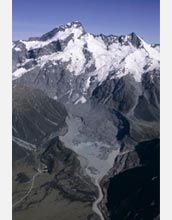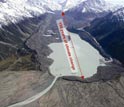|

Press Release 09-085
Glacial Advances

Glaciers in the Southern Hemisphere are growing out of step with those in the North
April 29, 2009
The vast majority of the world's glaciers are retreating as the planet gets warmer. But a few, including glaciers south of the equator in South America and New Zealand, are inching forward. A paper in this week's issue of the journal Science puts this enigma in perspective; for the last 7,000 years, New Zealand's largest glaciers have often moved out of step with glaciers in the Northern Hemisphere, pointing to strong regional variations in climate. "This research should provide much more accurate reconstructions of glacial advances worldwide, allowing us in turn to make climate models more accurate," said Paul Filmer, program director in the National Science Foundation's (NSF) Division of Earth Sciences, which funded the research. Conventional wisdom holds that during the era of human civilization, climate has been relatively stable. The new study is the latest to challenge this view, by showing that New Zealand's glaciers have gone through rapid periods of growth and decline during the current interglacial period known as the Holocene. "New Zealand's mountain glaciers have fluctuated frequently over the last 7,000 years, and glacial advances have become slightly smaller through time," said Joerg Schaefer, lead author of the paper and a geochemist at Columbia University's Lamont-Doherty Earth Observatory. "This pattern differs in important ways from the northern hemisphere glaciers. The door is open now towards a global map of Holocene [a geological time period that began about 11,700 years ago and continues to the present] glacier fluctuations and how climate variations during this period impacted human civilizations." Glaciers are extremely sensitive to changes in temperature and snowfall, which makes them well suited for studying past climate. This archive has been largely untapped, however, because of the difficulty in assigning precise ages to glacier fluctuations. One way to measure glacial fluxes is by studying the moraines, or rock deposits that glaciers often leave behind at their maximum points of advance. However, until now the methods of dating such moraines, including radiocarbon dating of organic matter, could be off by hundreds of years. By refining the analysis of a method called cosmogenic dating, Schaefer and colleagues were able for the first time to assign precise ages to young Holocene moraines. They accomplished this by measuring minute levels of the chemical isotope beryllium 10 in the rocks, which is produced when cosmic rays strike rock surfaces, and builds up over time. The researchers were thus able to pinpoint exactly when glaciers in New Zealand's Southern Alps began to recede, exposing the rocks to the cosmic rays. From the results, they constructed a glacial timeline for the past 7,000 years and compared it against historic records from the Swiss Alps and other places north of the equator. They found that within that timeframe, the glaciers around Mount Cook, New Zealand's highest peak, reached their largest extent about 6,500 years ago, when the Swiss Alps and Scandinavia were relatively warm. That's about 6,000 years before northern glaciers hit their Holocene peak during the Little Ice Age, between 1300 and 1860 AD. That finding was a surprise to some scientists who assumed that the northern cold phase happened globally. The record in New Zealand shows other disparities that point to regional climate variations in both hemispheres. The new chemical and analytical protocols are expected to allow scientists to accurately date glacier fluctuations throughout the Holocene, rounding out the climate picture on the continents. "With this measure we can go to almost any mountain range on earth and date the moraines in front of the glaciers and produce a similar chronology," said co-author George Denton, a glaciologist at the University of Maine and an adjunct scientist at Lamont-Doherty. Overall, glaciers around the world have been declining since about 1860, with the exception of a brief advance in Switzerland in the 1980s, New Zealand in the late 1970s through today, and a few other places. Changes in wind and sea surface temperatures are thought to be causing these regional fluctuations. Currently in a wet phase, New Zealand is expected to swing back to a warmer, drier phase in the next few years, causing the glaciers to retreat once again. The study also received funding from the Comer Science and Education Foundation, and the New Zealand Foundation for Research, Science and Technology. Other researchers involved in the study were: Michael Kaplan and Roseanne Schwartz, also of Lamont-Doherty; Aaron Putnam, University of Maine; Robert Finkel, CEREGE, France; David Barrell, GNS Science, New Zealand; Bjorn Anderson, University of Oslo; Andrew Mackintosh, Victoria University of Wellington, New Zealand; Trevor Chinn, Alpine and Polar Processes Consultancy, New Zealand; Christian Schluchter, University of Bern, Switzerland.
-NSF-

Media Contacts
Cheryl Dybas, NSF (703) 292-7734 cdybas@nsf.gov
Kim Martineau, LDEO (845) 365-8708 kmartine@ei.columbia.edu

The National Science Foundation (NSF) is an independent federal agency that supports fundamental research and education across all fields of science and engineering. In fiscal year (FY) 2009, its budget is $9.5 billion, which includes $3.0 billion provided through the American Recovery and Reinvestment Act. NSF funds reach all 50 states through grants to over 1,900 universities and institutions. Each year, NSF receives about 44,400 competitive requests for funding, and makes over 11,500 new funding awards. NSF also awards over $400 million in professional and service contracts yearly.
 Get News Updates by Email Get News Updates by Email
Useful NSF Web Sites:
NSF Home Page: http://www.nsf.gov
NSF News: http://www.nsf.gov/news/
For the News Media: http://www.nsf.gov/news/newsroom.jsp
Science and Engineering Statistics: http://www.nsf.gov/statistics/
Awards Searches: http://www.nsf.gov/awardsearch/
| 




